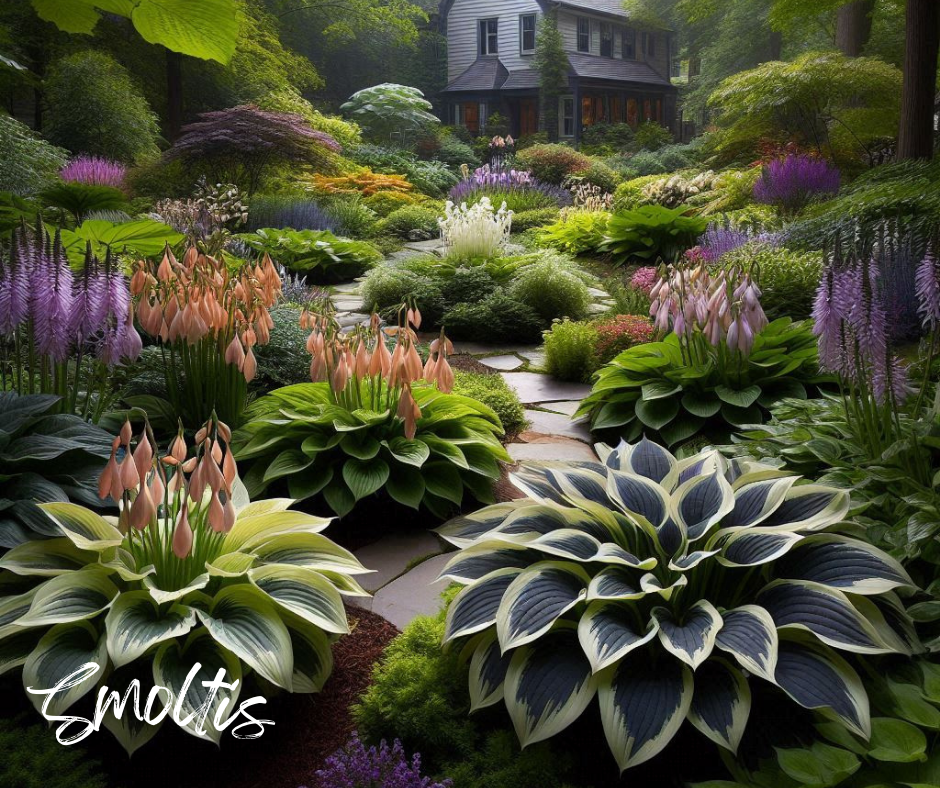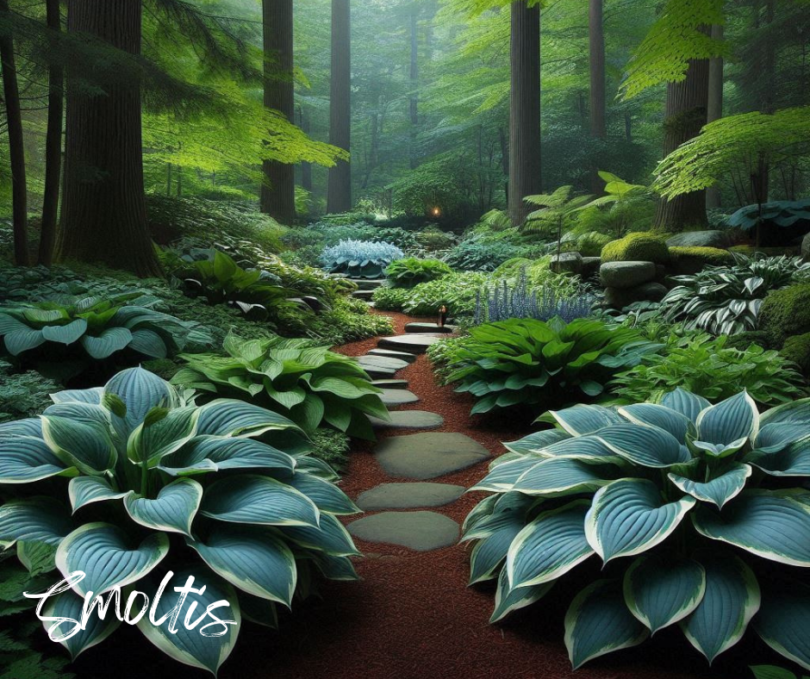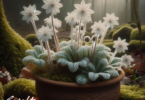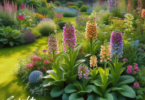Hostas are incredibly versatile perennial plants that thrive in shady areas, making them an excellent choice for shade gardens. These low-maintenance plants offer a wide range of foliage colors, textures, and sizes, and can be used to create lush, inviting outdoor spaces even in the darkest corners of the garden. With their striking leaves and occasional blooms, hostas are often referred to as the “kings of shade gardens.”

Key Takeaways
- Hostas are versatile perennial plants that excel in shade gardens.
- These low-maintenance plants offer a wide range of foliage colors, textures, and sizes.
- Hostas can create lush, inviting outdoor spaces even in the darkest corners.
- Hostas are often referred to as the “kings of shade gardens” due to their striking leaves and occasional blooms.
- Shade gardens can be transformed into beautiful and diverse outdoor spaces by embracing shade-tolerant plants like hostas.
Introduction to Shade Gardens
Gardening in shady areas can present unique challenges, as many traditional garden plants require full sun exposure to thrive. However, there is a vast array of beautiful, shade-loving plants that can transform these dimly lit spaces into lush, inviting oases. Shade gardens offer a serene and peaceful atmosphere, often resembling tranquil woodland gardens. By embracing the natural characteristics of shade-tolerant flowers, foliage plants, and understory species like hostas, ferns, and groundcovers, gardeners can create stunning and diverse low light gardening spaces that are both visually appealing and low-maintenance.
The Challenges of Gardening in Shady Areas
Many gardeners struggle with the challenges of growing plants in partial shade or low light conditions. Traditional sun-loving plants often fail to thrive in these shaded environments, leaving gardeners to find alternative solutions. Understanding the unique needs and adaptations of shade-tolerant plants is the key to creating a successful and vibrant shade garden.
The Beauty of Shade-Loving Plants
While the lack of direct sunlight may seem limiting, the world of shade-loving plants offers a wealth of beauty and diversity. From the lush, foliage plants like hostas and ferns to the delicate blooms of shade-tolerant flowers, these plants can transform a dimly lit corner into a serene and captivating woodland garden. By strategically incorporating a variety of understory plants, gardeners can create a layered and visually striking shade garden that showcases the natural elegance of these shade-adapted species.
Hostas: The Kings of Shade Gardens
Hostas are undoubtedly the stars of the shade garden, offering a wide range of foliage colors, shapes, and textures that can elevate any shaded space. From the broad, cathedral-like leaves of the ‘Empress Wu’ to the delicate, ruffled edges of the ‘Halcyon,’ there is a hosta variety to suit every gardener’s preference and every level of shade.
Varieties of Hostas for Different Shade Levels
Whether you’re working with deep, dense shade or more partial shade areas, there are hostas that will thrive and provide a lush, eye-catching presence in your garden. The ‘Hosta Krossa Regal,’ for example, with its striking blue-green foliage, thrives in low light conditions, while the ‘Hosta Patriot’ adds a pop of color with its variegated leaves in partial shade. Gardeners can explore a diverse selection of hostas to create stunning woodland-inspired landscapes or elegant understory plantings.
Unique Foliage Colors and Textures
Hostas are renowned for their diverse array of foliage colors and textures, making them a versatile choice for shade gardens. From the glossy, heart-shaped leaves of the ‘Hosta Halcyon’ to the matte, heavily-veined foliage of the ‘Hosta Sum and Substance,’ these plants offer a visual feast for the eyes. Gardeners can mix and match different hosta varieties to create captivating contrasts and harmonious compositions, elevating the overall aesthetic of their shaded spaces.
Shade Gardens
Shade gardens offer the opportunity to create a visually captivating and layered landscape. By strategically placing taller plants, such as trees or shrubs, in the background, and then incorporating mid-sized hostas and other shade-loving perennials in the middle ground, gardeners can craft a sense of depth and dimension.
Creating a Layered Effect
The key to a successful shade garden is to embrace the unique characteristics of shade-tolerant plants and use them to create a harmonious and visually striking outdoor space. This includes incorporating ground-covering plants, like woodland ferns or low-growing flowers, to help fill in the understory and contribute to the lush, naturalistic feel.
Incorporating Other Shade-Tolerant Plants
In addition to hostas, a variety of other shade-tolerant plants can be used to enhance the diversity and visual interest of a shade garden. Ferns, groundcovers, and understory plants, such as bleeding hearts, lamium, and barrenwort, can all thrive in the partial shade conditions, adding texture, color, and interest to the garden composition.
Caring for Hostas and Shade Gardens
Maintaining a thriving shade garden requires careful attention to the unique needs of the plants. Hostas, in particular, are known for their lush, verdant foliage, which requires consistent moisture to keep it looking its best. Regular watering, especially during hot and dry spells, is essential for these shade-tolerant plants to thrive.
Watering and Mulching Techniques
In addition to regular watering, applying a thick layer of organic mulch around the base of the hostas and other shade-loving plants can help retain soil moisture and suppress the growth of weeds. This not only benefits the plants but also enhances the overall aesthetic of the shade garden, creating a neat and well-maintained appearance.
Pest and Disease Prevention
Gardeners must also be vigilant in monitoring for common hosta pests, such as slugs and deer, which can quickly damage the delicate foliage. Implementing appropriate pest control measures, such as using organic slug deterrents or installing deterrents to keep deer at bay, can help protect the plants. Additionally, gardeners should be proactive in addressing any disease issues that may arise, such as powdery mildew or leaf spot, to ensure the long-term health and vibrancy of their shade gardens.
By following these basic care guidelines, gardeners can ensure that their shade gardens, including the iconic hostas, remain healthy, vibrant, and beautiful for years to come.
FAQ
What are the key benefits of growing hostas in a shade garden?
Hostas are incredibly versatile perennial plants that thrive in shady areas, making them an excellent choice for shade gardens. These low-maintenance plants offer a wide range of foliage colors, textures, and sizes, and can be used to create lush, inviting outdoor spaces even in the darkest corners of the garden. With their striking leaves and occasional blooms, hostas are often referred to as the “kings of shade gardens.”
What are the challenges of gardening in shady areas?
Gardening in shady areas can present unique challenges, as many traditional garden plants require full sun exposure to thrive. However, there is a vast array of beautiful, shade-loving plants that can transform these dimly lit spaces into lush, inviting oases. Shade gardens offer a serene and peaceful atmosphere, often resembling tranquil woodland settings.
What are some of the unique features of hosta varieties?
From the broad, cathedral-like leaves of the ‘Empress Wu’ to the delicate, ruffled edges of the ‘Halcyon,’ there is a hosta variety to suit every gardener’s preference and every level of shade. Whether you’re working with deep, dense shade or more partial shade areas, there are hostas that will thrive and provide a lush, eye-catching presence in your garden.
How can gardeners create a layered effect in a shade garden?
Shade gardens offer the opportunity to create a visually captivating and layered landscape. By strategically placing taller plants, such as trees or shrubs, in the background, and then incorporating mid-sized hostas and other shade-loving perennials in the middle ground, gardeners can craft a sense of depth and dimension. Additionally, incorporating ground-covering plants, like woodland ferns or low-growing flowers, can help fill in the understory and create a lush, naturalistic feel.
What are some essential care tips for maintaining a thriving shade garden?
Maintaining a thriving shade garden requires a few key considerations. Hostas, in particular, need consistent moisture to keep their lush foliage looking its best, so regular watering is essential, especially during hot, dry spells. Applying a thick layer of organic mulch around the plants can also help retain soil moisture and suppress weeds. Additionally, gardeners should be vigilant in monitoring for common hosta pests, such as slugs and deer, and take appropriate measures to prevent or address any disease issues that may arise.







